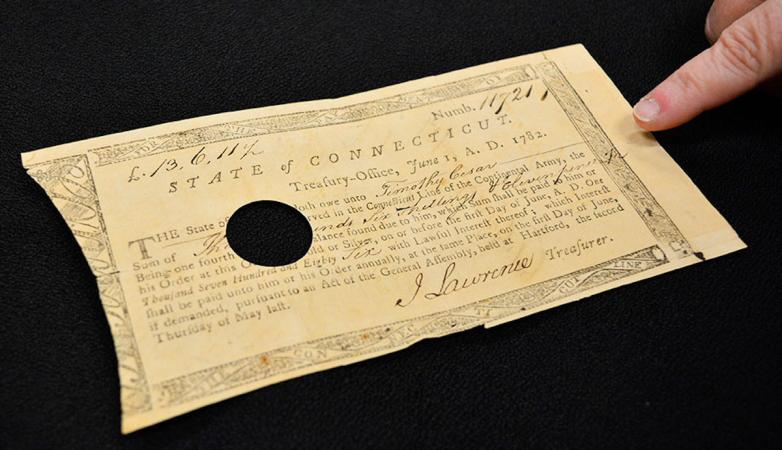MoAR Acquires Archive Related to Revolutionary War Soldiers of Color

One of the pay vouchers from the archive.
Philadelphia — Timothy Cesar. Cuff Liberty. Jabez Pottage. Jonas Sunsaman. Nearly 200 rare documents bearing the names of Black and Native American soldiers who served during the Revolutionary War are now in the collection of the Museum of the American Revolution.
The archive was acquired from a private collection, thanks to the generosity of several donors. The collection of original muster rolls, pay vouchers, enlistment papers, discharge forms, and other documents was assembled from auctions, rare manuscript dealers, and other collectors over the past two decades. The archive documents the military service of men of African and Native American descent who served in the ranks of the Continental Army.
“Telling the story of the American Revolution accurately means telling an inclusive story that acknowledges the diverse populations engaged in the Revolutionary conflicts,” said Dr. Philip C. Mead, the Museum’s Chief Historian. “But, as a museum, one of our greatest challenges is that relatively few possessions known to have belonged to people of color in the Revolutionary era have survived for us to display. That is what makes this archive so rare and exciting.”
“To be able to see the names of these men and know that they held these papers in their hands is incredibly powerful,” said Mead. “They also document the complicated racial dynamics of an army fighting for the principle that ‘all men are created equal’ in a nation where slavery was still legal.”
The Museum plans to display select documents as rotations in its core galleries and in the upcoming special exhibition The Fortens of Philadelphia, which opens in February 2023. Plans are also underway to digitize the documents, supplemented with supporting materials, as a robust new resource for scholars, educators, students, and other communities of learners. Additional funding is needed for conservation and to support the development of educational programming related to the archive.
“Thousands of men of color fought in the Continental Army, but their stories aren’t as known as they should be,” said Dr. R. Scott Stephenson, Museum President and CEO. “This archive allows us to explore the extraordinary lives of these men, who wore the uniform of the United States, helped to secure its independence and prosperity, and yet who have not received the recognition they deserve as American founding fathers. We are thrilled to have the opportunity to reconstruct these rich human stories and share them with the world.”
The vast and varied archive includes such documents as a discharge for a Black soldier, Brister Baker, who served for six years in the Continental Army, signed by General George Washington. A pay voucher from the summer of 1778 documents the service of Cuff Liberty, a formerly enslaved man who purchased his own freedom and may have chosen the surname “Liberty” to celebrate his new status. An exceptionally rare 1779 pay list from the First Rhode Island Regiment includes signatures of soldiers from the only Continental Army unit explicitly formed with a promise of absolute freedom to “every able bodied negro, mulatto, or Indian man slave” in its ranks. It features the names and signatures of 38 men of color.
The archive has already started to inspire new questions about the stories of some of these soldiers of African descent. One of the documents contains the signature of “Pomp London,” a nickname used by an African-born man named Boyrereau Brinch, or Jeffrey Brace, an enslaved man who served for five years in the Continental Army. In 1810, Brace published The Blind African Slave, one of very few memoirs of Black soldiers. The document will be on display at the Museum on Feb. 17 as part of the evening Read the Revolution Speaker Series event, which will feature a conversation with Dr. Kari J. Winter, who republished Brace’s powerful memoir in 2005, and Brace’s descendant, Rhonda Brace.
Other documents help elevate the stories of the often-forgotten sacrifices of Native American soldiers who fought and died in Revolutionary War service. A provision list from 1778 documents the supplies granted to the family of Jonas Sunsaman, a member of the Mashantucket Pequot community in Connecticut while he was away in service. Sunsaman died at Valley Forge on January 31, 1778. In accordance with Connecticut law, the town of Groton provided his family with small amounts of mutton, salt pork, and flower to offset the depreciation in the value of soldiers’ pay.
A 1780 voucher documents compensation received by Tuis Sharper, a Connecticut soldier of African and Native American ancestry, who served in uniform for at least six years, including nearly a year as a prisoner of war. A 1780 certification of service for a Native American soldier named James Pottage testifies that he had served in the Connecticut line for at least ten months and was entitled to the same pay as other troops.















